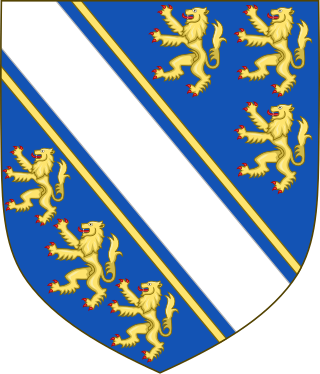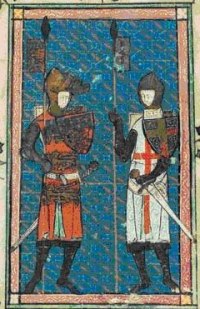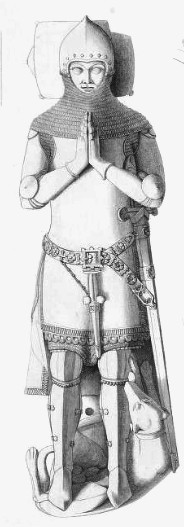Today is the seventh centenary of the battle of Boroughbridge. In the battle the forces of Thomas, Earl of Lancaster and Humphrey Earl of Hereford were defeated by the Royalist troops, loyal to King Edward II and led by Sir Andrew Harclay. Lancaster himself was captured and Hereford killed in the fighting.
This was the military culmination of the decade long struggle for power between the King and the Lords Ordainers, led by his cousin Lancaster, who sought to constrain the monarch snd exclude or eliminate his favourites, first Piers Gaveston, who was killed in 1312, and by 1322 the Despensers. The victory of the King’s army led to what is often termed the tyranny of King Edward II which lasted until the invasion led by his estranged Queen, Isabella of France, in the autumn of 1326.

The arms of the Earl of Lancaster
These are still used by the Duchy of Lancaster
Image: Wikipedia
The outbreak of civil war in 1322 originated over disputes over the activities of the Despensers in south Wales and a perceived insult to the Queen. Lancaster and his troops after retreating from a reverse at the bridge at Burton on Trent on March 7th made for his castle at Pontefract. There in an apparently factious meeting at the Blackfriars Lancaster was compelled by his allies to retreat northwards towards his castle at Dunstanburgh on the coast of Northumberland. In the meantime he was being pursued by the Earl of Kent - the King’s younger half-brother - and the Earl of Surrey - for whom Lancaster’s wife Alice had left him - or at least been abducted by - some years earlier. That had resulted in a local civil war in Yorkshire with attacks by Lancaster on Surrey’s castles at Sandal and Conisburgh. Alice never returned to Thomas and the story of her very eventful life is told by Wikimedia at Alice de Lacy, Countess of Lincoln
However Lancaster was beaten to the crossing of the river Ure at Boroughbridge by Sir Andrew Harclay, from Carlisle, a man in his early fifties, who had once a retainer of Lancaster but who was now committed to the King. Wikipedia has an account of his career at Andrew Harclay, 1st Earl of Carlisle
The arms of Sir Andrew Harclay
Image: Wikipedia
When Harclay arrived with his men from Cumberland and Westmorland at Ripon he was informed of Lancaster’s plan and marched during the night the short distance to take the bridge at Boroughbridge as well as the higher northern bank of the river before the Earl could arrive.

A modern impression of the battle at the timber bridge
Image: Alchetron.com
Wikipedia has a good account of the battle itself and useful links, as well as above average footnotes for the site. The plan gives an indication of not only the site of the bridge but also of the likely position of the ford which Lancaster and his men had to approach across marshy ground under fire from the other side of the Ure. It can be viewed at Battle of Boroughbridge
Boroughbridge Historical Society are organising events to commemorate the battle as can be seen at Events to mark 700th anniversary of Battle of Boroughbridge
After an overnight armistice, during which Yorkshire troops in the King’s service arrived from the south, and with Harclay’s men still on the north bank and holding the bridge, Lancaster finally accepted defeat and surrendered.
The chapel of St James where Lancaster took his final refuge, and doubtless somewhat altered over the succeeding medieval centuries, survived until it was regrettably demolished in 1852 and a new church erected on a new site.
The tower of the Victorian church reflects the design of that of its predecessor. The new church does also include some sculptured Norman work from the original twelfth century chapel, as can be seen, together with two drawings of the old church before its demolition, at St James, Boroughbridge, Yorkshire, West Riding. Earl Thomas must have doubtless seen some of this during his last hours of freedom.
The body of the Earl of Hereford, of whom
Wikipedia has a life which draws attention to the cultured world of him and his family and which can be read at Humphrey de Bohun, 4th Earl of Hereford appears to have been sent to be buried in the cathedral at Hereford where an effigy of him survives.
Image: Wikipedia

Arms of the Earl of Hereford
The Earl’s standard bearer died beside him on the bridge
Image: Wikipedia
Following his surrender on the day after the battle Lancaster, humiliated by being dressed in servants clothing, and cursing Harclay for the insult and prophesying - accurately - Sir Andrew’s death within the year, was taken by river to York and thence, possibly again by water for speed and security, to his castle at Pontefract, there to await the King and his ultimate fate ….

Thomas Earl of Lancaster paired with St George in a posthumous image reflecting his cult as a martyr figure.
Image: Bodleian and Historic-UK.com



No comments:
Post a Comment